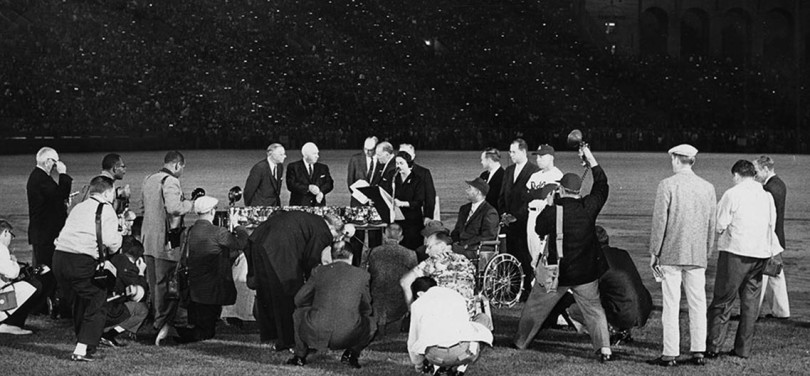
Reference Biography: Walter O’Malley
1959: A Year of Change - Part 2
Examiner columnist Flaherty wrote on May 17, 1959 about Chavez Ravine, “It had been a civic eyesore for years — a little lost dump of a wilderness, cut off from the heart of the city by-passed by the years and shunned by a growing community. Nobody wanted it. Few seemed to know what to do with it. It was to be a housing development and that was dropped. It was to be the site of a new jail, and then it wasn’t. It was to be cleared for a zoo, and that was forgotten.
“But when the Dodgers came to town, overnight Chavez Ravine became important! Then and only then, it seemed a few people did have long-standing schemes for the area for personal gain or self-aggrandizement, or both.
“Prior to that it was a dumping place for trash and tin cans. Main Street itinerants wandered into the area and camped out. Winos robbed one another there in the dark of night, and bodies of some were found there.
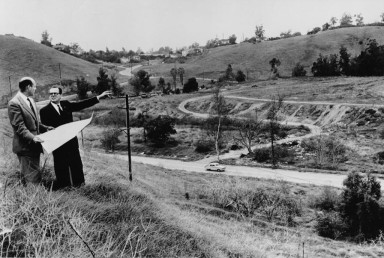
Los Angeles Mayor Norris Poulson (right), an instrumental leader in bringing the Dodgers to the West Coast, stands and views barren land in the hilly area known as Chavez Ravine with sportswriter Bob Hunter of the Los Angeles Examiner on Aug. 28, 1957.
AP Photo
“But when the Dodgers came to town, induced by the city which offered the place as a site for a new baseball park, in return for Wrigley Field, the Ravine became a big thing. It became the most important piece of local real estate since Cecil B. DeMille and other movie pioneers started operations in a Hollywood barn.
“Glossed over during the furore of a calculated farce is the fact the Dodgers had absolutely nothing to do with the evictions in the area. Indeed, the Dodgers had never even heard of the place until the name was brought up by local officials during the orderly process of negotiations. The officials were glad for the opportunity to have the sickly area converted into a glamour spot, a tourist attraction, by the Dodgers. The incoming major league team pledged itself to building a $12,000,000 baseball stadium, finest in the world — in addition to a public recreation area that wouldn’t cost a penny.
“Years before the Dodgers decided to move to Los Angeles the Ravine property had been officially condemned and eviction notices had been served. The family that has raised most of the ugly hullabaloo has been living there ever since, tax-free. A check for more than $10,000 has been awaiting this family all the while for their ramshackle property. Yet the same family while owning 11 other known homes, didn’t raise a voice when a collection was taken up for it...Or when a new trailer was hauled into the Ravine to provide housing for the ‘destitute’ people. Of course, when the truth leaked out, the ‘destitute’ family was kicked out of the trailer and the trailer was hauled away.
“The truth always surfaces sooner or later. J.A. Smith, the man who put up most of the money to instigate a referendum vote on the Ravine, later admitted he wanted to promote a trade fair in the area. His name had been seldom mentioned during the taking up of petitions. Some of the petitioners were found to have been paid as much as 25 cents a signature. Many of the petitioners were found to have obtained signatures through absolute fraud.
“‘Sign here,’ they urged sports fans at the Coliseum, ‘if you want major league baseball.’ Hundreds who signed didn’t realize they were signing AGAINST major league baseball.
“...Los Angeles has been made to look like a stupid nut house of a town. During the whole drawn-out and unsavory business the Dodgers, through no fault of their own, have been made the fall guys.” Vincent X. Flaherty, Los Angeles Examiner, May 17, 1959
Setting aside major legal hurdles, O’Malley could finally do what he had wanted to do for nearly 10 years — begin construction of a new stadium.
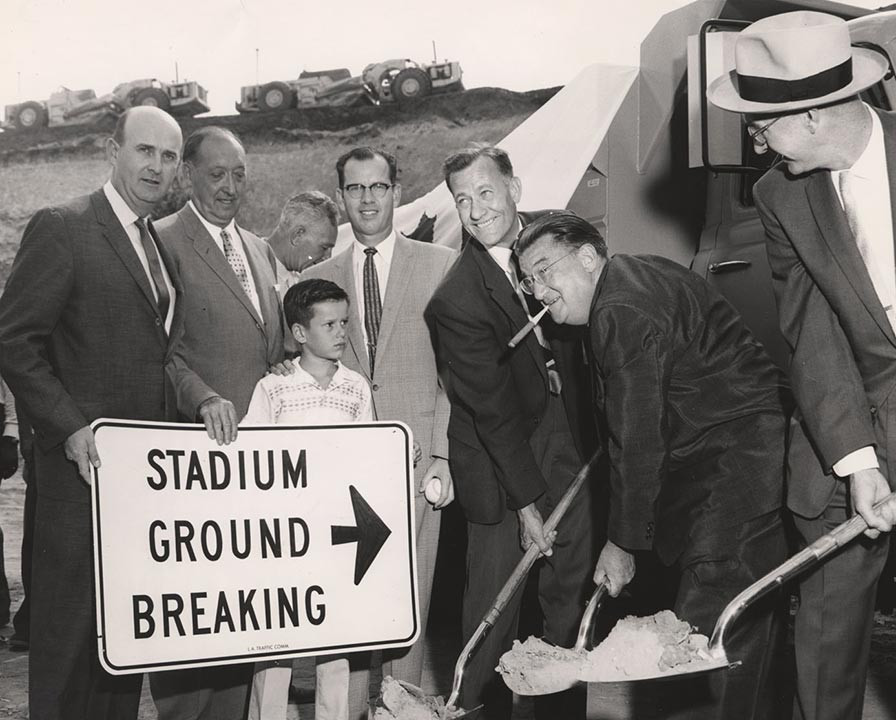
Among the dignitaries at the Sept. 17, 1959 Dodger Stadium groundbreaking ceremonies was (l-r) City Councilman Gordon Hahn; Jack Yount, in charge of construction for Vinnell Constructors; County Supervisor Kenneth Hahn and his son Jimmy (who was honorary batboy and years later elected as Mayor of L.A.); C. Don “Arch” Field of the L.A. City Department of Public Works; Walter O’Malley; and Al Vinnell of Vinnell Constructors.
He broke ground for Dodger Stadium on September 17, 1959, holding a shovel alongside Supervisor Hahn, his son Jimmy Hahn (who was designated as the Dodger batboy and years later became Mayor of L.A.), Mayor Poulson, City Councilman Gordon Hahn, Dodger Vice President, Stadium Operations Dick Walsh and members of the architectural and construction teams, including engineer and designer Capt. Emil Praeger, Jack Yount and Al Vinnell of Vinnell Constructors.
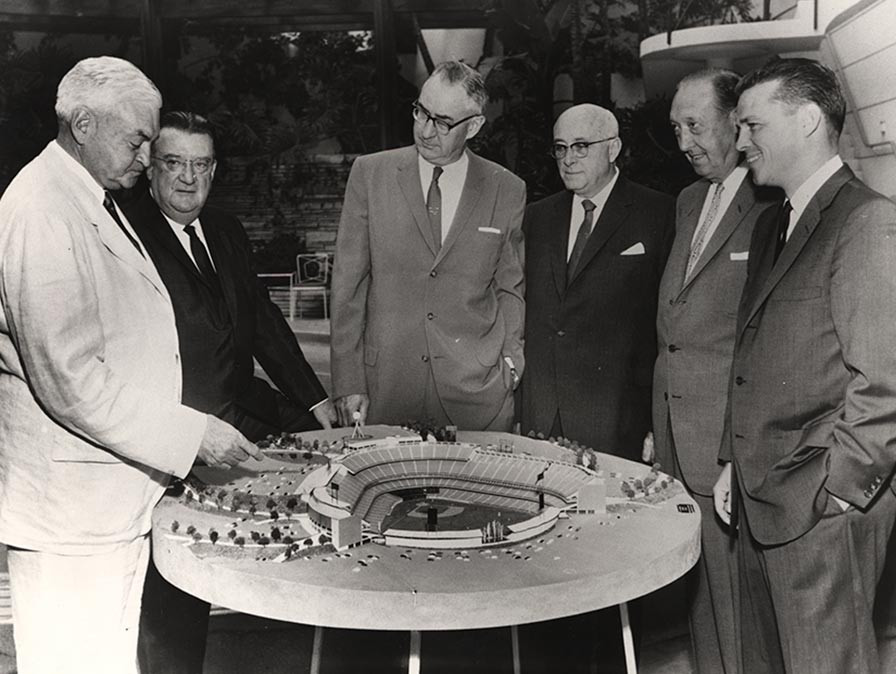
With a circa 1960 model of Dodger Stadium are (L-R) Capt. Emil Praeger, designer; Walter O’Malley; Al Vinnell of Vinnell Constructors; James Mulvey, Dodger Vice President and stockholder; Jack Yount of Vinnell Constructors and on-site construction manager; and Dick Walsh, Dodger Vice President, Stadium Operations.
It was one of the proudest moments of O’Malley’s life, as he knew that he would finally see his stadium dream realized.
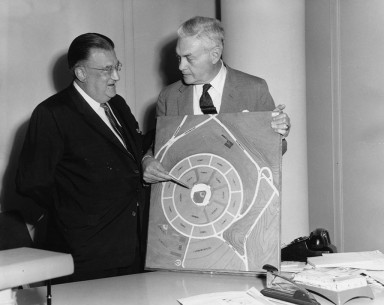
Walter O’Malley and Captain Emil Praeger inspect the model of the new 56,000-seat Dodger Stadium.
Courtesy of University of Southern California, on behalf of the USC Specialized Libraries and Archival Collections
Praeger, senior partner of New York City firm of Praeger, Kavanagh and Waterbury, was a Navy captain who had an impeccable record as an authority on bridges, foundations and parkways. He was the consulting engineer for the structural and foundation design for the White House renovation in 1949. Previously, he provided his first stadium design for the Dodgers’ 5,000-seat Holman Stadium project in 1952-53 and was engineer for the Los Angeles Public Library. Captain Praeger, like O’Malley, was a stickler for details. “Skimp on the little things and the big thing won’t be a success. That’s engineering,” said Capt. Praeger. “Four Engineers + One Architect = Diversified Consulting Firm,” Engineering News-Record, February 7, 1963
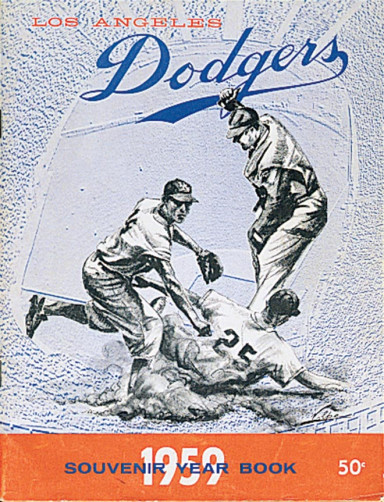
1959 Dodgers Yearbook
Copyright © Los Angeles Dodgers, Inc.
The 1959 Dodgers surprised their new hometown following with an 88-68 record, good enough to tie with the Milwaukee Braves for the N.L. lead. The Dodgers beat the Braves in the best-of-three playoff series, 2-0, to earn the N.L. Pennant and the right to meet the American League Champion Chicago White Sox. The Dodgers defeated the Sox in six games, four games to two, behind the pitching of Larry Sherry, the World Series MVP. For the first time, Los Angeles would have a World Championship banner fly over its city. It was O’Malley’s second World Series title in five seasons. According to Southern California Business published by the Los Angeles Chamber of Commerce in its October 26, 1959 edition, “Southland business received a boost of nearly $3,000,000 spent by out-of-town visitors attending the 1959 World Series games at the Coliseum.” Southern California Business, published by the Los Angeles Chamber of Commerce, October 26, 1959 edition
Another of numerous darts was thrown O’Malley’s way a month after the 1959 World Series. A majority of Los Angeles City Council voted 9 to 5 to change the zoning for Chavez Ravine, permitting commercial development and parking lot areas and insisted on a new subdivision map before Dodger Stadium could be built, delaying the process for up to two years.
An irritated O’Malley proclaimed, “If these constant delays occur our location in Los Angeles may become untenable and we may accept offers to move elsewhere. If you attempt to rewrite this contract, which I do not believe you can do, I will not be able to finance the Dodger project in Chavez Ravine.” Los Angeles Herald-Express, November 5, 1959
City Planning Director John E. Roberts said at the meeting that new subdivision and tract maps would have to be filed and that it would take at least six months to process. In addition, a conditional use for the building of the baseball stadium would have to be approved by Huber E. Smutz, City Zoning Administrator. That process could take months to complete.
Given the opportunity to speak before the City Council by Mrs. Wyman, O’Malley reiterated his position that if the contract which had been approved by the Council, the mayor, the voters and the courts was changed, the Dodgers would have to look elsewhere to make a new home. Given O’Malley’s sincere approach, this was no idle threat by a man who had quickly become disillusioned with the entire process.
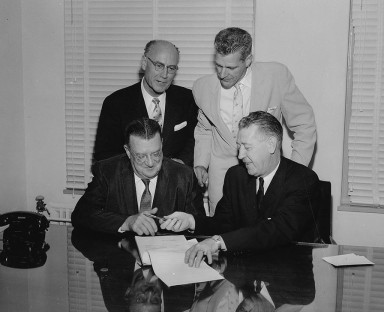
Walter O’Malley prepares to sign the official contract with the City of Los Angeles which will enable him to build Dodger Stadium, ending legal challenges on June 3, 1959. Seated next to O’Malley is Los Angeles City Council President John S. Gibson. Standing (l-r) is Councilman Ransom Callicott and City Attorney Roger Arnebergh.
Los Angeles Times Collection, UCLA Library Special Collections
In fact, O’Malley had several options, if Los Angeles could not honor its contract with the Dodgers. Although New York politicians dreamt about him returning there when things were on shaky ground in Los Angeles, O’Malley was approached by many California cities and Chambers of Commerce, as well as private landowners. The cities of Downey, Westminster, Norwalk, Buena Park all approached O’Malley about providing the necessary land for Dodger Stadium, while Chambers of Commerce from El Monte Community, Quartz Hill and Manhattan Beach did the same. Individual landowners and developers contacted the Dodgers from San Fernando, Venice, Dominguez Water Company in Long Beach (Dominguez Junction in Torrance), Compton, Maywood and Universal-International in Studio City. City Councilman Harold Henry wanted to explore an arrangement with the State of California, City and County of Los Angeles to finance a stadium in Exposition Park, leasing it back to the Dodgers.
However, the process was expedited when the Los Angeles City Council voted to impose a conditional use restriction on the Dodger Stadium land. This gave O’Malley the ability to secure financing, while the zoning and planning departments stepped up their timelines. The Council’s close decision also limited the events that could be held by the Dodgers.
On October 19, 1959, the Silver complaint eventually went to the U.S. Supreme Court, where an appeal request was not heard and was finally dismissed.
“The Supreme Court of the United States, by this decision, has upheld the two unanimous decisions of the California Supreme Court,” O’Malley wrote on October 19, 1959. “We trust it will remove from the scene any further political delays so that we may proceed to build the beautiful Los Angeles Dodgers Stadium and Recreation area. I look forward now to a spirit of cooperation and understanding among all public officials that will permit us to complete the new stadium at the earliest possible date next fall.
“I wish to give our sincere thanks to the voters and public officials of the City and County of Los Angeles who have supported the Dodger contract. The decision reaffirms, and again vindicates, their judgment.
“I do hope there will be an end to further dilatory tactics. During the course of the years of litigation we have been careful not to discuss the merits of the matter but now we can point out that the hardship was not only one of delay but one of financial concerns. The cost of the new stadium project was increased $2,500,000 by the delay and further an increase of $500,000 is expected in May. This is one reason why we have been reluctant to exercise our option on the Coliseum for next year. We will soon confer with the Coliseum Commission and I am sure we will be able to arrange a lease that will be fair to the Coliseum and in keeping with other baseball leases in effect in Milwaukee, Baltimore, Kansas City, Cleveland and other cities where municipally-owned stadiums are rented.
“All we want to do is to be able to meet our financial obligations caused by increased costs of the new stadium necessitated by the legal delays.”
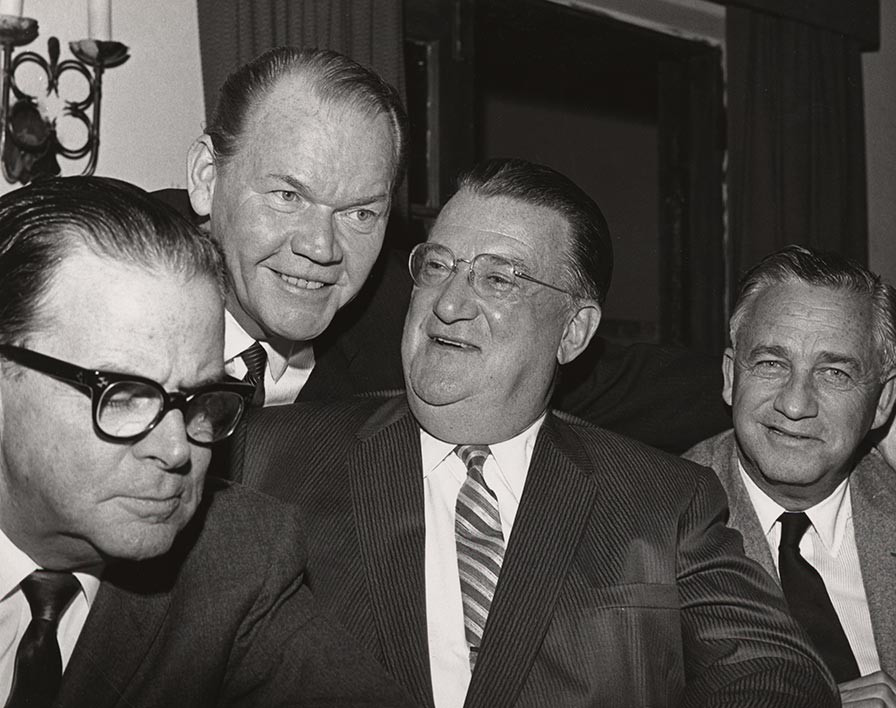
From left, Los Angeles Mayor Norris Poulson, Los Angeles Examiner columnist Vincent X. Flaherty, Walter O’Malley and renowned Hollywood producer Mervyn LeRoy. Flaherty was one of the staunchest supporters of bringing Major League Baseball to the West Coast, as he began corresponding with O’Malley in 1953.
But delays there would be. As O’Malley was preparing by contract to exchange Wrigley Field in Los Angeles for Chavez Ravine another battle began, as a dozen remaining residents banded together to sell their property in unison. The City of Los Angeles made its last and best offer based on fair-market appraisals, but owners were not accepting it, blocking the way for O’Malley. The city dropped its condemnation proceedings, forcing O’Malley to act. Records show the appraised total for these 12 properties to be $85,750 in 1960. O’Malley ended up spending a greatly-inflated $494,200 to purchase the 12 properties so that he could continue to move forward in the process. O’Malley had all legal right and title to the land, but nevertheless many residents held it against him and not the federal government, Housing Authority or city officials. The fact remains, however, that no property owners should have been on the land after 1951-52.
Perhaps, O’Malley’s feelings might have been summed up best by well-respected baseball writer and historian Leonard Koppett of the New York Post on June 4, 1958, who took the liberty of re-writing the words to Cole Porter’s “Begin the Beguine” in parity which starts “Why did I begin with Chavez Ravine?” The little ditty continues, “Who roadblocked my path to fabulous riches? Where did I slip, get caught in the switches, When all appeared so serene? * Chavez Ravine — looked so green, Green as the sheen that you’ve seen on something called money, But who could know that referendum are funny? No one can tell what they mean. Not even a “Yes” completes my endeavor. I still have to press for roads on my site. Lawsuits now may continue forever, Though I know it’s clever never to fight. So, though it’s a sin to stick to the screen, To stay in L.A. I may play in the Coliseum, Even if Chavez winds up as a mausoleum With my hopes just a dream. Oh, why did I begin the ravine? Why did I tumble for the pitch of a betrayer? Now I’ve got me a ditch — but which? — with Paulson, the mayor, Both of us need some morphine. * Though I’m winning an election, I’m still not in. I’ve lost votes among councilmen who last year I took in. Now and then I can’t help but wish I’d stood in Brooklyn, Where I wouldn’t have been In the trouble I’m in Since I started in — that ravine.” Leonard Koppett, New York Post, June 4, 1958

